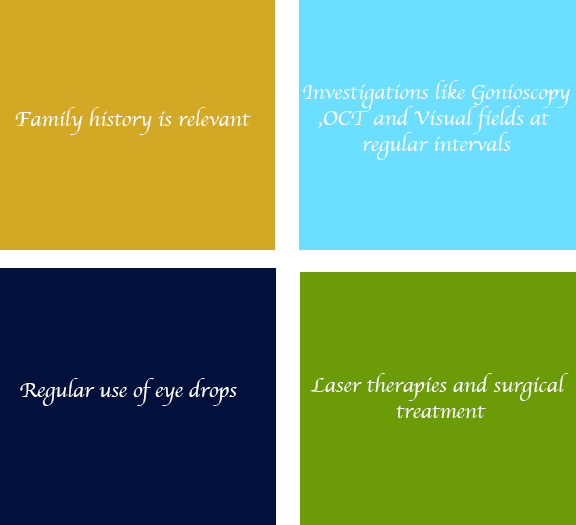
GLAUCOMA (काला मोतिया)
The silent thief of vision
What causes Glaucoma?
काला मोतिया क्यों होता है ?
At the front of the eye, there is a small space called the anterior chamber. Clear fluid flows in and out of the chamber to bathe and nourish nearby tissues. In Glaucoma there is an impairment in the dynamics of this fluid called aqueous humour due to varied causes, some of which are unknown leading to increase in intraocular pressure. Unless this pressure is controlled, it may cause damage to the optic nerve and loss of vision.
Diagnostic For Glaucoma
Glaucoma can be easily diagnosed with simple and effective tests which can help in quantifying the anatomical as well as functional loss due to the disease. These tests are advised regularly during the follow up visits or when the disease is not under control and help in proper management of the patient. Early in the course of the disease these tests may be needed frequently, however frequency of these tests may reduce, as the disease is under control.

What is the treatment?
Glaucoma is one of the leading causes for loss of vision worldwide. However, this vision loss can be avoided by timely intervention, which is usually very simple in the form of medical treatment. Patients benefit from our state-of-the-art Glaucoma testing capabilities with specially trained Glaucoma specialists who are experts in diagnosing and providing either medical or surgical management for all types of Glaucoma. Although Glaucoma cannot be cured, it can usually be controlled. Early diagnosis and treatment helps in improving the quality of life and this vision can be preserved throughout life. Regular monitoring is an essential part of Glaucoma treatment and every glaucoma patient should visit his doctor regularly as advised.
Why Manocha Eye Hospital
Glaucoma cannot be cured, but it can surely be controlled with the help of regular medications, eye drops, laser treatment, and surgery, etc. At Manocha Eye Hospital, we emphasise on careful evaluation of the optic nerve and investigate patients thoroughly with the use of latest diagnostic and advanced machines like OCT, Visual Fields, Non Contact Tonometry.
Through our Glaucoma treatment, which varies depending on an individual's eye condition, we aim to lower IOP in the eye, thereby reducing any further damage caused to the optic nerve.
Myths / Frequently Asked Questions
- People over age of 45: While Glaucoma can develop in younger patients, it occurs more frequently as we get older.
- People who have a family history of Glaucoma: Glaucoma appears to ‘run’ in families. The tendency for developing Glaucoma may be inherited. However, just because someone in your family has Glaucoma does not mean that you will necessarily develop the disease.
- People with abnormally high intraocular pressure (IOP): High IOP is the most important risk factor for Glaucomatous damage.
- People who have Diabetes, Myopia, Regular, long-term Steroid use and a previous eye injury.
The most common symptoms of congenital/infantile glaucoma are excessive tearing, light sensitivity and a large, cloudy cornea. Excessive tearing accompanied by mattering/discharge in a child is usually not caused by glaucoma but instead is the result of congenital nasolacrimal duct obstruction.
We at Sankara are committed towards not only, spreading awareness about this vision threatening disease but also towards proper care of a patient with Glaucoma.
There are several ways to help yourself remember when to put your drops in:
- A chart with tick boxes,
- A box with compartments for the drop bottles,
- A special timer can be set to ring several times each day as required.
The unopened bottle will have an expiry date. Once opened, drops will last about four weeks.
Most beta blocker drops are stable up to at least 25 degrees Celsius.
Steroid (cortisone-type) drops and tablets should be used with caution because they can increase the pressure in the eye. If you have had a glaucoma operation, steroid drops or tablets are safer.
Some other tablets may interact with glaucoma treatments. Always mention to your doctor that you are having glaucoma treatment and your doctor will advise you.
Please remember that eye drops are powerful medications and that they can interact with other treatments.
